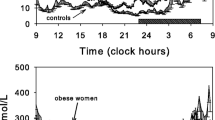Abstract
Leptin communicates nutritional status to regulatory centers in the brain1,2. Because peripheral leptin influences the activity of the highly pulsatile adrenal and gonadal axes3,4, we sought to determine whether leptin levels in the blood are pulsatile. We measured circulating leptin levels every 7 minutes for 24 hours, in six healthy men, and found that total circulating leptin levels exhibited a pattern indicative of pulsatile release, with 32.0 ± 1.5 pulses every 24 hours and a pulse duration of 32.8 ± 1.6 minutes. We also show an inverse relation between rapid fluctuations in plasma levels of leptin and those of adrenocorticotropic hormone (ACTH) and cortisol that could not be accounted for on the basis of glucocorticoid suppression of leptin. As leptin levels are pulsatile, we propose that a key function of the CNS is regulated by a peripheral pulsatile signal. In a separate pilot study we compared leptin pulsatility in 414 plasma samples collected every 7 minutes for 24 hours from one obese woman and one normal-weight woman. We found that high leptin levels in the obese subject were due solely to increased leptin pulse height; all concentration-independent pulsatility parameters were almost identical in the two women. Leptin pulsatility therefore can be preserved in the obese.
Similar content being viewed by others
References
Zhang, Y. et al. Positional cloning of the mouse obese gene and its human homologue. Nature 372, 425–432 (1994).
Spiegelman, B.M. & Flier, J.S. Adipogenesis and obesity: Rounding out the big picture. Cell 87, 377–389 (1996).
Ahima, R.S. et al. Role of leptin in the neuroendocrine response to fasting. Nature 382, 250–252 (1996).
Chehab, F.F., Lim, M.E. & Lu, R. Correction of the sterility defect in homozygous obese female mice by treatment with the human recombinant leptin. Nature Genet. 12, 318–320 (1996).
Oerter, K.E., Guardabasso, V. & Rodbard, D. Detection and characterization of peaks and estimation of instantaneous secretory rate for episodic pulsatile hormone secretion. Comput. Biomed. Res. 19, 170–191 (1986).
Houseknecht, K.R. et al. Evidence for the existence of leptin binding to proteins in serum of rodents and humans: Modulation with obesity. Diabetes 45, 1638–1643 (1996).
Veldhuis, J.D. & Johnson, M.L. Cluster analysis: A simple, versatile, and robust algorithm for endocrine pulse detection. Am. J. Physiol. 250, E486493 (1986).
Licinio, J. et al. Twenty-four hour concentrations of circulating interleukin-2 in healthy women exhibit episodic fluctuations: Analysis of integrated basal levels and discrete pulse properties. Endocrine 1, 120–128 (1993).
Sinha, M.K. et al. Nocturnal rise of leptin in lean, obese, and non-insulin-dependent diabetes mellitus subjects. J. clin. Invest. 97, 1344–1347 (1996).
Jenkins, G.M. & Watts, D.G. Spectral Analysis and Its Applications. (Holden Day, San Francisco, CA,1968).
Chrousos, G.P. et al. The corticotropin-releasing factor stimulation test: An aid in the evaluation of patients with Cushing's syndrome. N. Engl. J. Med. 310, 622–626 (1984).
Sutton, R.E., Koob, G.F., LeMoal, M., Rivier, J. & Vale, W. Corticotropin-releasing factor produces behavioural activation in rats. Nature 297, 331–333 (1982).
Gold, P.W., Kaye, W., Robertson, G.L. & Ebert, M. Abnormalities in plasma and cerebrospinal-fluid arginine vasopressin in patients with anorexia nervosa. N. Engl. J. Med. 308, 1117–1123 (1983).
Gold, P.W. et al. Responses to corticotropin-releasing hormone in the hypercortisolism of depression and Cushing's disease: Pathophysiologic and diagnostic implications. N. Engl. J. Med. 314, 1329–1335 (1986).
Fehm, W.G., Bachholz, G., Born, J., Voigt, K. & Fehm, H.L. Vasopressin but not oxytocin enhances cortical arousal: An integrative hypothesis on behavioral effects of neurohypophyseal hormones. Psychopharmacology (Berl) 94, 496–500 (1988).
Schwartz, M.W., Seeley, R.J., Campfield, L.A., Burn, P. & Baskin, D.G. Identification of targets of leptin action in rat hypothalamus. J. Clin. Invest. 98, 1101–1106 (1996).
Schwartz, M.W., Dallman, M.F. & Woods, S.C. Hypothalamic response to starvation: Implications for the study of wasting disorders. Am. J. Physiol. 269, R949–R957 (1995).
Sinha, M.K. et al. Ultradian oscillations of leptin secretion in humans. Biochem. Biophys. Res. Commun. 228, 733–738 (1996).
Homburg, R. et al. One hundred pregnancies after treatment with pulsatile luteinising hormone releasing hormone to induce ovulation. Br. Med. J. 298, 809–812 (1989).
Zinaman, M.J., Cartledge, T., Tomai, T., Tippett, P. & Merriam, G.R., Pulsatile GnRH stimulates normal cyclic ovarian function in amenorrheic lactating postpartum women. J. Clin. Endocrinol. Metab. 80, 2088–2093 (1995).
Aulitzky, W., Frick, J. & Hadziselimovic, F. Pulsatile LHRH therapy in patients with oligozoospermia and disturbed LH puisatility. Int. J. Androl. 12, 265–272 (1989).
Turzillo, A.M., Juengel, J.L. & Nett, T.M. Pulsatile gonadotropin-releasing hormone (GnRH) increases concentrations of GnRH receptor messenger ribonucleic acid and numbers of GnRH receptors during luteolysis in the ewe. Biol. Reprod. 53, 418–423 (1995).
Haisenleder, D.J., Ortolano, G.A., Yasin, M., Dalkin, A.C. & Marshall, J.C. Regulation of gonadotropin subunit messenger ribonucleic acid expression by gonadotropin-releasing hormone pulse amplitude in vitro. Endocrinology 132, 1292–1296 (1993).
Haisenleder, D.J., Dalkin, A.C., Ortolano, G.A., Marshall, J.C. & Shupnik, M.A. A pulsatile gonadotropin-releasing hormone stimulus is required to increase transcription of the gonadotropin subunit genes: Evidence for differential regulation of transcription by pulse frequency in vivo. Endocrinology 128, 509–517 (1991).
Veldhuis, J.D. The hypothalamic pulse generator: The reproductive core. Clin. Obstet. Gynecol. 33, 538–550 (1990).
Maiter, D., Underwood, L.E., Maes, M., Davenport, M.L. & Ketelslegers, J.M. Different effects of intermittent and continuous growth hormone (GH) administration on serum somatomedin-C/insulin-like growth factor I and liver GH receptors in hypophysectomized rats. Endocrinology 123, 1053–1059 (1988).
López-Fernández, J. et al. Growth hormone induces somatostatin and insulin-like growth factor I gene expression in the cerebral hemispheres of aging rats. Endocrinology 137, 4384–4391 (1996).
Glaum, S.R. et al. Leptin, the obese gene product, rapidly modulates synaptic transmission in the hypothalamus. Mol. Pharmacol. 50, 230–235 (1996).
Campfield, L.A., Smith, F.J., Guisez, Y., Devos, R. & Burn, P. Recombinant mouse OB protein: Evidence for a peripheral signal linking adiposity and central neural networks. Science 269, 546–549 (1995).
Michelson, D. et al. Multiple sclerosis is associated with alterations in hypothalamic-pituitary-adrenal axis function. J. Clin. Endocrinol. Metab. 79, 848–853 (1994).
Author information
Authors and Affiliations
Rights and permissions
About this article
Cite this article
Licinio, J., Mantzoros, C., Negrão, A. et al. Human leptin levels are pulsatile and inversely related to pituitary–ardenal function. Nat Med 3, 575–579 (1997). https://doi.org/10.1038/nm0597-575
Received:
Accepted:
Issue Date:
DOI: https://doi.org/10.1038/nm0597-575
- Springer Nature America, Inc.
This article is cited by
-
The effect of an orally-dosed Caralluma Fimbriata extract on appetite control and body composition in overweight adults
Scientific Reports (2021)
-
Depression and obesity: evidence of shared biological mechanisms
Molecular Psychiatry (2019)
-
Seasonal consumption of polyphenol-rich fruits affects the hypothalamic leptin signaling system in a photoperiod-dependent mode
Scientific Reports (2018)




